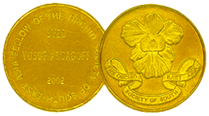- OSSEA
- November 17, 2017
- Posted in

This year’s Singapore Orchid Show was the sixth held as part of the Singapore Garden Festival, and the second at the Flower Dome, Gardens by the Bay, in conjunction with an Orchid Extravaganza.
Every show has its own distinctive character, and this one was marked by a great range of less commonly seen orchids, many of them cool growing. It was also a larger show than in 2014. There was a total of 567 plants on display, an increase of well over a hundred, and they were drawn from no less than 108 different genera. Of these 567 competitive plants, 163 were species and 404 were hybrids.
Compared to some shows 567 competitive orchids may not sound a lot. In shows gone by numbers in the thousands have been mentioned, but these figures have always included numerous orchids that are essentially fillers, massed groups in landscapes or in decorations. And despite a flirtation, in the 20th WOC, with a system under which the judging team themselves decided which plants would be considered, local exhibitors and judges still favour the traditional system in which plants to be judged are registered and grouped for judging. So the actual competitive exhibits are the core of the show, and 567 is a respectable number. On the other hand, we should not be complacent.
If we go back in time to the pre-war shows, there were generally close to 400 exhibits, which made up in number what they lacked in variety. Such numbers were possible because in those days amateurs were wealthy and grew their orchids in quantity, in extensive private gardens. An advertisement in the Straits Times for 5 March 1932 offered to sell 5 to 6ft Vanda Joaquim [sic] plants at $120 per thousand, the price including planting and three months care.
The competitive plants came from a total of 34 exhibitors: 10 professionals from Germany, Japan, Malaysia, Taiwan and Thailand, 10 professionals from Singapore, and 14 amateurs, all from Singapore. Although OSSEA is an amateur society, this participation indicates the strong support it enjoys from professional growers here and overseas. None gave stronger support than the Singapore Botanic Gardens and Gardens by the Bay, both of which sent numerous excellent plants from their own collections. We were fortunate to have available 36 well-qualified judges, 14 from Singapore and 22 variously from Australia, Germany, Indonesia, Malaysia (East and West), Myanmar, Japan, Taiwan, Thailand, Vietnam, the UK and the USA. Several exhibitors and judges were new to the Singapore Orchid Show, but we hope we will see them again in future.
The layout of this year’s show was a great improvement on that of 2014, for this time the orchids were spaced out around the Flower Dome, in a sequence of three enclosed gardens (Australian, South African and Mediterranean), where they were discreetly mounted or hung on apparatus devised by the Extravaganza designer, Alan Tan of Living Décor. Alan had also decorated each garden with a backdrop – or sometimes what seemed like a ceiling – of complementing orchid blooms. In some cases, notably in the use of white phalaenopsis, these backdrop plants were of a very high quality.
Then there were in addition two illuminated vivaria filled with miniature orchids in flower, expertly set up by Joseph Yeo. Visitors, having gently descended through the Dome viewing these sights, were finally confronted by the display of trophy winning plants, with their trophies. After this, they left the show and plunged into the fantasy world of the Orchid Extravaganza in the Flower Field.
Turning to the plants, Au Yong Kien Chung of Orchidwoods, Sarawak, exhibited the Grand Champion Aranthera (Aranthera James Storie x Renanthera storiei). This augured well for the forthcoming Asia Pacific Orchid Conference in 2019, which Sarawak.is hosting. Gardens by the Bay exhibited the Reserve Grand Champion, a spectacular Pinalia floribunda and also gained a silver medal for its unusual primary hybrid Dendrobium Kuniko with flowers in a rich blue inherited from its parent Den victoriaereginae. A stunning rhynchostylis retusa, exhibited by Woon Leng Nursery, was awarded the Best Species and Best Specimen Plant. This species has its habitat in the north reaches of South East Asia and is difficult to grow well in Singapore. Among the other trophy winners, Christopher Teo collected the trophy for the Best Foliage Orchid for his Ludisia discolor, also known as the Jewel Orchid, while new exhibitor Marei Karge-Liphard, from Orchideengarten, collected two trophies, for Coelogyne Orchideengarten Clara and a particularly deeply coloured Maxillaria tenuifolia. Paphiopedilum Harold Koopowitz, exhibited by Ching Hua Nursery, was the best slipper orchid from a large field this year, and the best Arethusae was taken by a magnificent variegated Spathoglottis Garden City exhibited by the Singapore Botanic Gardens. Among amateurs, Christopher Teo, as so often, won the most points for the placings gained by his many plants, earning H.H. the Sultan of Johor’s Perpetual Trophy.
The diversity of genera in this show provided the opportunity to see plants rarely seen here. An example was Pleurothallis alvaroi, a cool-growing Colombian orchid. Others included miniatures such as Haraella retrocalla; Schoenorchis fragrans from Northern Thailand, India and Burma; the Brazilian Phymatidium falcifolium; and Pleurothallis truncata, an epiphytic and sometimes lithophytic species found in Ecuador. A beautifully grown collection of different colour forms of Dendrobium cuthbertsonii, exhibited by the Singapore Botanic Gardens, almost filled an entire vivarium.
Other orchids not often seen were Promenaea Partridge ‘A’, a primary hybrid of two Brazilian species (stapeliodes x guttata), which had two small but interestingly patterned flowers; and the New World Maxillaria striata with its big flower. Hailing from the cloud forests of Ecuador were Dracula vampira and Dracula cordobae commonly referred to as Monkey-Faced Orchids), which are rarely grown here due to their need for cool conditions and very clean water.
Also present were some unusual plants from common genera, such as Phalaenopsis lobbii with its small flowers some 2.5 cm high; the Vietnamese miniature Dendrobium trantuanii; Dendrobium moniliforme, another plant with variegated leaves, which is found on forest trees from Japan through Korea and China; and the Colombian Masdevallia coccinea with its brilliant red flowers. Damrong Hongsaevatham of Thailand received a gold medal for his vibrant Japanese primary hybrid Dendrobium Hibiki (bracteosum x laevifolium).
At the show, the public also saw a New World terrestrial, Anguloa clowesii, a beautiful yellow tulip-like orchid found at 2000 m in Colombia and Venezuela. They also saw a wonderful example of why Oncidium and its allies are commonly called Dancing Lady Orchids. From the picture of Oncidium Ron’s Rippling Delight (fuscatum x schroederianum) one can clearly see the lady’s hands and head held high, and her swirling skirt, even her face, in the flowers.
Some local hybrids were also on display, including two new, yet-to-be-registered crosses exhibited by the Singapore Botanic Gardens. The first was a very big-flowered, spectacular, Spatulata section hybrid, Dendrobium (Tengah Black Panther x lasianthera). The second was Spathoglottis (Seletar Park x plicata). These might be potential VIP orchids. Our own David Lim’s recently registered Vanda Norgard GEM showed perhaps a new trend in colour, pastel shades of pale blue with deep brown markings. Christopher Teo also exhibited his striking, yet-to-be-registered plant of Vanda (Kenny Gold x Suksamran Spots).
The show had a very good collection of Vandaceous orchids. It was particularly nice to see the beautiful but difficult-to-grow Vanda sanderiana. This Philippine species (the Waling-Waling) is famous for its significant role in vandaceous hybridisation, being in the ancestry of over 6,300 hybrids. It was also a pleasure to see David Lim’s Paraphalaenopsis serpentilingua, which received an Award of Merit from the OSSEA judges. The flowers had outstanding colour markings for the species, which is just one of four in the genus and is found in the lowland swampy forests of Borneo.
There are many people to be thanked for their work behind the scenes at registration, setup, teardown, in the sales booth and in the secretariat, to make the show a success. A full appreciation and list of volunteers can be found in the Society’s Bulletin for July & August 2016. In addition, as Show Chair, I gratefully acknowledge the help of the National Parks Board, and their staff, especially CEO Kenneth Er, Botanic Gardens Director Nigel Taylor, and David Lim, Manager of the National Orchid Garden; and the CEO of Gardens by the Bay Dr Kiat Tan and all his staff, especially Andrea Kee, Edwin Ong, Aloysius Joo andAndy Kwek. The Agri-Veterinary Authority Singapore, and particularly Ong Ai Khim, kindly assisted in facilitating plant clearance at Changi Airport.
I would also like to thank all exhibitors and Judges, and special thanks must go to Lee Nam Fook, Cheah Wah Sang, Top Think Biotechnology, and Marei Karge-Liphard, for generously donating their exhibits to the Society, where they have been auctioned to eager buyers and thus contributed to restoring – somewhat – our depleted coffers, and increasing the happiness of OSSEA members.



